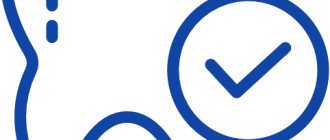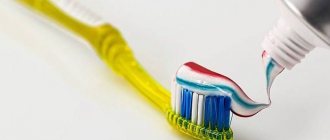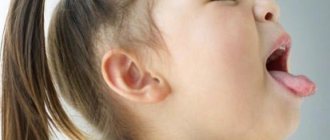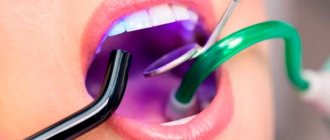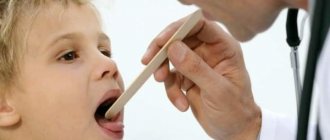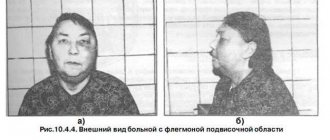- Why is it important to care for baby teeth?
- Which toothpaste to choose for a child
- How to choose a toothbrush for a child
- What is xylitol and why is it important?
- How to teach a child to brush their teeth
- Tips from a pediatric dentist: video
Often parents do not attach importance to caring for their child’s baby teeth, postponing this issue until the permanent teeth appear. This approach can harm the health of your teeth and gums in the future. To ensure that visits to the dentist do not frighten your child and are preventative, you need to start taking care of your teeth as early as possible.
Tartar
Tartar is a soft plaque that has been in the mouth for so long that it has hardened to such an extent that it seems to “ stick ” to the tooth. At the same time, in addition to difficulties with hygiene, the stone can cause inflammation of the marginal gum - swelling and bleeding, causing constant discomfort. As a result, children try to avoid inflamed areas when brushing their teeth.
The result of this process is gingivitis and stomatitis , and in advanced cases, gum atrophy occurs along with exposure of the dental necks. The sensitivity of teeth to temperature and other influences increases significantly .
Which toothpaste to choose for a child
There are many different baby pastes on the shelves. It is very important that the product is not only effective and safe, but also tasty. Delicious toothpaste will help quickly accustom your child to regular brushing.
In addition to toothpaste, you should try Tooth Mousse - a remineralizing gel to strengthen tooth enamel, which helps get rid of hypersensitivity and prevent the development of caries. There is no sugar in it, and the main components of the gel are calcium and phosphates - the basis of our teeth.
Should not be in children's toothpaste
Until a certain age, children tend to try everything, including toothpaste. Therefore, the safety of its composition is especially important. Children's toothpaste should not contain: SLS, parabens, titanium dioxide (hard abrasive). If the paste foams, it means it contains SLS, and it is better to discard it.
In addition, for proper care it is important that the baby toothpaste contains a minimum amount of abrasive substances. Soft abrasives are necessary for effectively cleaning teeth from plaque in adulthood, but there should be little of them in the composition of children's toothpaste. On the packaging, the degree of abrasiveness is indicated by the abbreviation RDA and for children ranges from 0 to 20. It is better to choose pastes with 0 RDA.
Children's toothpaste should contain the following substances:
- Fluorine
. An important substance for teeth, so toothpaste should contain a small amount of fluoride, which is usually indicated on the package. For children under 4 years old - 200 ppm, from 4 to 8 years old - 500 ppm.
Dentissimo Junior Apple (from 6 years old)
Toothpaste ROCS (ROCS) Kids Berry Fantasy (from 4 to 7 years)
Brush-Baby Multifruit (from 3 to 6 years)
Biorepair Kids (from 0 to 6 years) with strawberry flavor
- Hydroxyapatite
. A modern alternative to fluoride. Synthetic hydroxyapatite is identical to the natural one that makes up enamel. Thanks to this, it easily integrates into its crystal lattice and strengthens it, sealing microcracks and reducing sensitivity. In addition, hydroxyapatite eliminates caries at the white spot stage. - Flavoring additives
. In addition to natural flavors, there are synthetic analogues that are completely safe for children. Toothpastes for children are produced in a variety of flavors: mint, citrus, eucalyptus, vanilla and many others.
How to remove plaque
Removing soft and hard plaque from teeth seems to be an elementary procedure, but, nevertheless, it requires the specialist, in addition to attention, to have some experience in such operations . The soft coating is removed with special rubber bands (or a brush). As a rule, children do not object to this - they do not experience discomfort or pain as a result of the procedure . But the importance of such a procedure is difficult to overestimate - despite its apparent simplicity, it can become an important preparation for subsequent treatment, accustoming the child to manipulations in the oral cavity.
In the case of tartar, special devices - ultrasonic or manual.
Frequency and periodicity of professional hygiene
Of course, the frequency of professional cleaning is different for each child , and depends mainly on the quality of dental care - some children brush their teeth so well that they can only be taken to a specialist annually, while others ...
When undergoing orthodontic treatment, crowded teeth or poor hygiene, preventive maintenance and professional cleaning should be performed as often as possible .
Do not underestimate the importance of professional cleaning - after all, during it, the doctor will not only teach the child how to properly care for his teeth, but will also select individual products or medications - this is especially important for various diseases or defects of the oral cavity. For example, if there is crowding, a regular toothbrush is not very effective; in this case, the child needs a special brush.
How to care for baby teeth?
You need to take care of your child’s baby teeth from the moment he is born. Here are some tips and rules.
- The longer the baby is breastfed, the stronger his teeth will be. because there is enough calcium and fluoride in breast milk.
- From the beginning of complementary feeding, the child should receive vegetables and fruits. They promote the secretion of saliva, which washes and cleanses the oral cavity.
- Gradually, the child needs to be taught to rinse his mouth to remove leftover food.
- Solid food should be on the menu. It strengthens the muscles of the dentition and promotes the formation of a correct bite.
- Before baby teeth erupt, the baby’s tongue and gums are wiped with a piece of gauze soaked in warm water.
- The first teeth are also wiped with damp gauze. –
- By the age of two, you can begin to accustom your child to the first brush
with very soft bristles. A dental hygienist will teach you how to use it correctly. - From the age of three, a child may have his first toothpaste
. However, it should not contain fluoride. Let it taste good. - Ideally, a child should get used to brushing their teeth at least 2 times a day - in the morning and before bed.
Features of professional oral hygiene
Oral hygiene in children three to five years old
- removal of plaque and plaque using rotary brushes (using low-abrasive pastes);
- floss polishing
- remineralizing therapy (local, using gels and jellies).
Oral hygiene in children six to ten years old
- determination of quality of care ( plaque markers
- regular teeth cleaning under the supervision of a specialist;
- hygiene index – the quality of the child’s teeth brushing, his mistakes;
- training in proper cleaning;
- repeated cleaning under the supervision of a specialist, taking into account her recommendations;
- removal of plaque and plaque using rotary brushes (using low-abrasive pastes);
- polishing with rubber heads and paste; strips (strips);
- remineralizing therapy (office or at home);
- local fluoridation using gels, jellies or varnishes.
Oral hygiene in adolescents aged eleven to sixteen
- removal of plaque and plaque using rotary brushes (using low-abrasive pastes and air-abrasive devices). For mineralized deposits - cleaning with ultrasonic tips ;
- periodontal soft tissue indices. If symptoms of inflammation are detected, anti-inflammatory treatment is carried out;
- remineralizing therapy (at the dentist or at home).
Professional hygiene in pediatric dentistry - prices*
| Name of service | Price | |
| Professional teeth cleaning for children from 3 to 5 years old, paste + brush | Make an appointment | 2000 rub. |
| Professional teeth cleaning for children with mixed dentition from 5 to 10 years old, gentle - Air Flow glycine | Make an appointment | 3200 rub. |
| Professional teeth cleaning for children from 10 years of age, Air Flow calcium carbonate | Make an appointment | 3900 rub. |
*The price list presented on the website is not complete and is not intended for independent calculation of the cost of treatment. You can request a full price list at the reception desks of the DLclinic medical center. However, the exact cost of the procedures is determined by the doctor after examining the patient.
You can find out more detailed information and schedule a consultation through the online form.
Make an appointment
(812) 232-88-25, 233-19-08, 383-19-66
Basic personal hygiene mistakes
- the procedure is performed too quickly ;
- cleaning occurs before eating ;
- no intermediate hygiene during the day (after meals);
- incorrect cleaning method. It is necessary to clean your teeth from all sides;
- insufficient care for hard-to-reach places - oral care methods
- poor selection of hygiene products. They also need to be constantly replaced with new ones;
- abuse of bleaching pastes based on peroxide compounds (usually with increased abrasive properties). This leads to the spread of pathogens .
All these mistakes often result from a lack of awareness among children and parents themselves about proper oral hygiene. To avoid this, regular consultations with an orthodontist are necessary.
Gum care in the first months of life
The first six months of life is the period when microbes populate the child’s mouth , which means that there is an increased likelihood of diseases - caries, stomatitis, infantile thrush, etc. Parents and other relatives often cause such diseases by transmitting germs to the baby through kisses, pacifiers, dishes and neglect to wash objects with boiled water. To minimize the risk, your child should wipe their gums with special wipes or finger tips every time after eating.
Cleaning baby teeth
Children should brush their baby teeth with a special brush for babies . At the beginning, the cleaning time should be 15-20 seconds , then the duration should be gradually increased . The most difficult thing at this moment, of course, is to arouse the child’s interest in this boring activity, from his point of view.
There are two methods as old as the world that have never lost their effectiveness:
- Turn hygiene training into a game - what little kid wouldn't love a flying spaceship brush or a superhero protecting his teeth? If the child is interested, he will voluntarily let his teeth be brushed and wait until the procedure is over. Perhaps even patiently.
- teach a child to do like mom or dad - children love to repeat after their parents. This feature can easily be used in the process of teaching children how to brush their teeth. Doing this with your child every day, you will find that your baby himself is demanding that the ritual be continued. The most important thing is that the pasta is to your taste .
It happens that toothpaste and brushes are simply not nearby, then dentists recommend chewing gum without sugar or a more traditional and healthy option - chewing an apple .
Hygiene education
The goal of health education is to achieve voluntary and conscious changes in a person’s attitude towards their health. Of course, changing people's behavior and habits remains a complex and lengthy process: it occurs gradually, in repeated steps, and at first can be reversible.
The maximum effect of hygienic education is achieved if it begins in early childhood, when the child listens and accepts the advice of adults and tries to copy their behavior.
Modern parents are ready to cooperate in the prevention of dental diseases: they themselves turn to doctors with questions about how to properly brush their teeth, what toothbrush and toothpaste to buy, what medications their child needs to prevent caries.
Systematic hygienic education of children and their parents by the staff of preschool and school institutions and dentists will form in children a conscious attitude to hygienic practices and create in every family the prerequisites for a healthy lifestyle according to the principle “it cannot be otherwise.”
